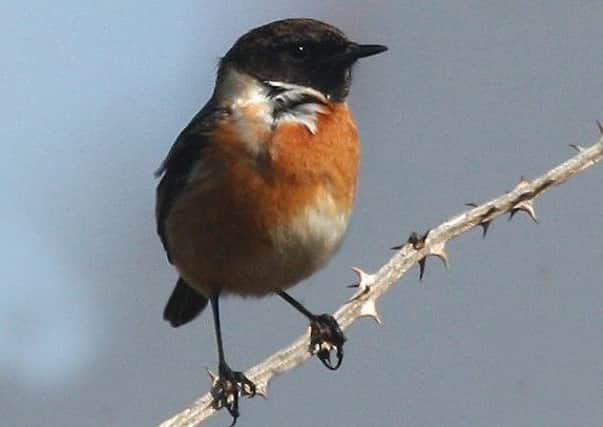Birdwatch: Stonechats, the birds happy to put in an appearance


They are pretty little birds and very obliging, perching on top of reeds or bushes flicking their wings and tails, so that they can clearly be seen.
The male has a round black head, white half collar and orange breast while the female is browner, with only the hint of a collar but with the same distinctive orange breast.
Advertisement
Hide AdAdvertisement
Hide AdThey breed on the uplands of the northwest and have a long season, producing three and sometimes four clutches.
The juveniles start to leave from mid summer while those adults leaving breeding territories do so from September onwards.
Some do not move far, setting up winter territories on lowland reedbeds and waste land where it is still possible to find small insects, while others continue onwards to France, Iberia and North Africa.
There are plenty of them around this winter, suggesting another good breeding season and a recent run of mild winters has boosted the survival rate.
Advertisement
Hide AdAdvertisement
Hide AdAnother stonechat to look out for is the Siberian stonechat, a few wandering individuals of which are seen here each winter as they arrive with other species from eastern Russia.
It can be told apart from our resident species in being darker above, paler below and with a white rump and in the male, a broader white collar and in 2011 it was decided that the Siberian should be given the status of a separate species.
Long-tailed ducks have been moving down the Yorkshire coast with six seen off Flamborough Head, others off Scalby Mills and Sewerby and inland at Tophill Low and the Burton Riggs reserve, Scarborough.
Great northern and black-throated divers were also reported along the coast while a few sooty shearwaters were also on the move south before heading through the Channel and back into the Atlantic again. A great northern diver and black-necked grebe were both back in Scarborough Harbour while a Slavonian and a red-necked grebe were seen in Filey Bay.
Advertisement
Hide AdAdvertisement
Hide AdNine shore larks were still at Long Nab north of Scarborough, there were a few snow buntings with two on Carr Naze, Filey and a flock of twite at Hunmanby Gap – at least one twite was among a flock of linnets at Orgreave Lagoons, South Yorkshire.
Two Bewick’s swans called in at Orgeave Lagoons while up to four were with more than 60 whooper swans at Hatfield Moors.
A male hen harrier has also been seen there while a juvenile pallid harrier continues to be reported at the Welwick Saltmarsh reserve in East Yorkshire.
The Yorkshire Wildlife Calendars for 2017, produced by Michael Flowers and costing £9.20 (incl p&p) are now available.
Advertisement
Hide AdAdvertisement
Hide AdThere are 16 photographs, accompanied by more than 300 suggestions on what to see and where and when you may see it. For more information, see www.eybirdwatching.blogspot.com or contact [email protected] or 07946 625688.